How to Use Intent Signals to Accelerate B2B Deals

What's inside







If it feels like you’ve been hearing more about buyer intent signals lately, it’s not just in your head. It’s a topic of conversation among revenue teams internally, on LinkedIn, and everywhere in between.
Companies are keen on intent signals because outbound has never been more challenging.
It can be a struggle to cut through the constant barrage of emails, LinkedIn messages, and calls that crowd every buyer’s inbox.
On top of that, only a small fraction of prospects are actually in-market at any given time. That means cold outreach is like spinning the roulette wheel, hoping you’ve contacted the right person at a good time.
Intent signals give you a better starting point by identifying which prospects have shown some level of interest or awareness, so cold outreach becomes a little warmer.
We’re seeing this growing interest reflected in the market as well.
What were once straight-up-and-down B2B contact data providers—platforms like Clearbit, Cognism, and Apollo—have all expanded beyond enrichment and into intent.
But not all intent signals are created equal. And simply gathering them won’t magically increase your win rate. You need to understand the context behind the signals and how to act on them.
What are intent signals?
Intent signals are indicators of buyer interest or readiness to purchase.
They’re like breadcrumbs that help you learn who’s interested, what they’re interested in, and where they are in the buying journey.
There are a lot of signals that could be considered an indicator of buyer intent, some stronger than others. Classic examples include:
- Clicking your ads
- Browsing review sites
- Attending your webinar
- Engaging with social media content
- Searching keywords relevant to your business
This intent data comes from a variety of sources, including third-party data providers (e.g., review sites), public information (e.g., press releases about a new funding round), and even your own website.
But, as we’ll explore later, the source of the intent signal plays a major role in its usefulness.
The three different types of intent signals
Intent signals can be divided into three categories:
- First-party
- Second-party
- Third-party
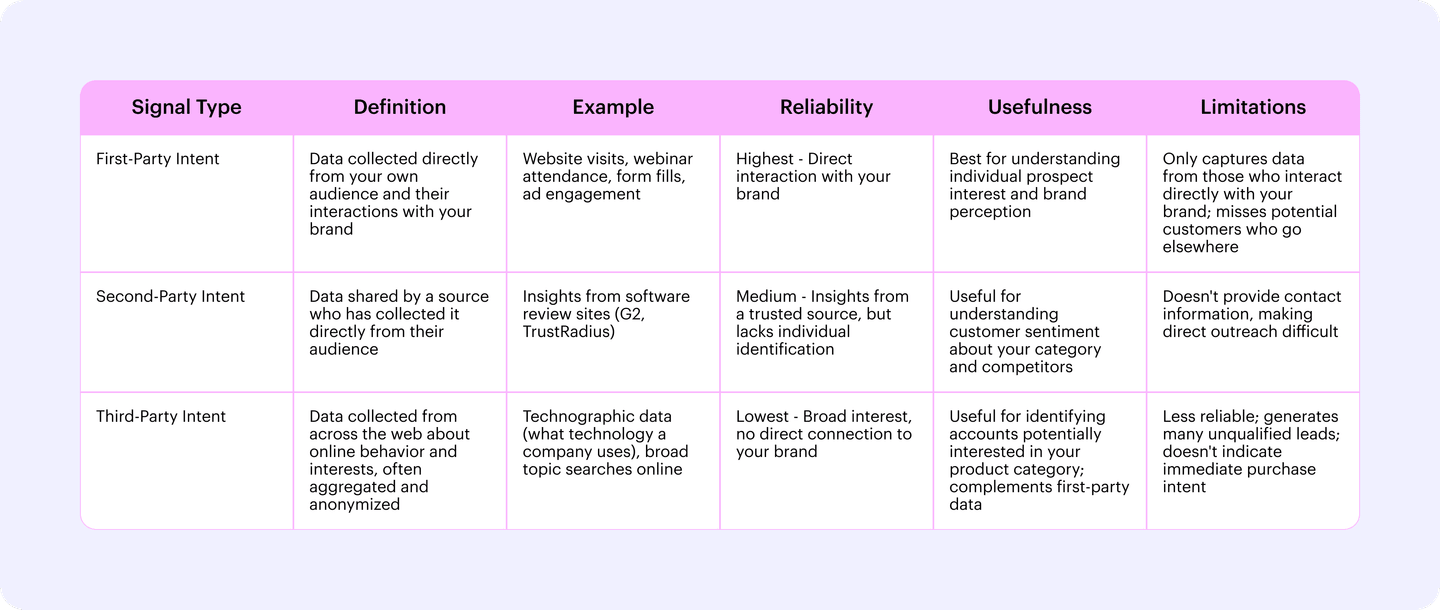
Let’s keep it simple (and delicious) by explaining it with tacos.
Imagine you run a taco stand.
First-party intent signals
This is like a customer coming directly to your taco truck for lunch.
They’re browsing your menu, asking about your prices, and checking out the ingredients list.
You know who they are and what they’re interested in because they’re engaging directly with your stand.
You have first-hand, personal data about their likes.
In marketing terms, they’re:
- “Clicking” on your menu (website visits)
- Coming to your “How to Make the Perfect Taco” cooking demo (webinar attendance)
- Filling out your loyalty card application (form fills).
Ad engagement is a great example of a strong first-party intent signal.
You run targeted contact-level ads to get in front of buying committee members, and then monitor ad engagement to understand each individual prospect’s intent.
First-party intent signals are by far the most reliable, though their effectiveness depends on the level of depth you’re able to access.
For example, some tools only give you account-level data for website visitors. They tell you that someone at a given company was on your website, but they don’t tell you who.
Then you have Influ2, which can tell you which of your target prospects has seen or engaged with your ads and which ads they clicked.

First-party signals are also super powerful because they help you understand what prospects think about your brand or product. If they’ve viewed your pricing page 10 times, for example, it's a sign they might be assessing budget—an important buying signal.
The downside of first-party signals is that they only tell you about people who are engaging with your brand directly, clicking on your ads or browsing website pages. You’re only capturing data on part of the market.
They don’t tell you about the people who eat at the taco stand down the street.
Second-party intent signals
Second-party intent signals are like teaming up with a local food blogger.
They can tell you who has read reviews of your taco stand and similar restaurants in the area on their website. But the caveat is that they can’t share the names of the actual people (contacts), just their neighborhood (accounts).
So, you don’t know which person in the account was doing the research.
The most common example of this in the marketing world is the insights that come from software review sites like G2 or TrustRadius.
These sites can tell you what customers think about your product category and competitors, but they usually don’t tell you who they are.
So you don’t know who to reach out to and offer a coupon to try out your carnitas.

Third-party intent signals
Now we’re talking about the broader taco universe.
These people have searched topics like “how to make a fish taco” or watched Anthony Bourdain tour through Mexico on YouTube.
They obviously like tacos, but there’s no sign that they are necessarily ready to buy yours.
Third-party intent data is gathered from the internet and gives a broad picture of a prospect’s intent to buy.
For example, it tells you what kind of technology an organization purchases (technographic intent data), or what topics an account searches for online.

Most marketers fixate on third-party intent signals because they’re widely available and give you access to a large audience.
However, they’re weaker and less reliable than first-party signals. They also result in a ton of uninterested or unqualified leads that might not fit your ICP (ask your sales team).
Third-party intent signals are best used to complement first-party signals.
For example, you’ve got first-hand ad engagement data that help you understand what a prospect cares about, and you couple that with third-party behavioral data to learn what competitors their company might also be considering.
Why layering data signals is the best way to establish buyer intent
The best way to get a full picture of buyer intent is to layer data from various sources (first, second, and third-party).
You might combine, for example, first-party ad engagement data, second-party review data from Capterra and G2, and third-party sales intelligence from Bombora to understand which of your target accounts are closest to buying.
The goal here is to make life easy for Sales by unifying all these signals and turning them into actionable context, ideally without putting any extra work on their plate.
For instance, with our Hubspot and Salesforce integrations, you can funnel Influ2 intent signals into your CRM.
This allows your salespeople to access these insights where they already work, instead of forcing them to log into the source of each intent signal to get context for prospects before reaching out.
Not all intent signals are created equal
Some signals demonstrate deeper buying intent than others. Booking a sales demo is usually seen as a stronger intent signal than attending a webinar, for instance.
When deciding how much weight to give a signal, we need to assess three factors:
- Reliability: How accurate and trustworthy is the data?
- Relevance: How much does the signal actually tell us about that prospect’s propensity to buy?
- Timeliness: How recent is the signal? (older data loses value)
There’s also the consideration of whether the intent signal came from the account, or contact level.
Account-level intent tells you which companies may be interested in topics related to your product. They’re the collective behavior of individuals within an account.
An ABM tool might tell you that employees at Tesla are browsing your product category on review sites, but they don’t tell you who is doing that research.
You don’t know if it's a high-level decision-maker actively looking for a product or a junior-level employee who’s just casually browsing.
Contact-level intent, on the other hand, tells you which specific influencers, champions, and decision-makers within an account are interested in which topics.
It can tell you, for example, that “Brian, the Head of Demand Generation, clicked on your ad about XYZ on June 3rd”.
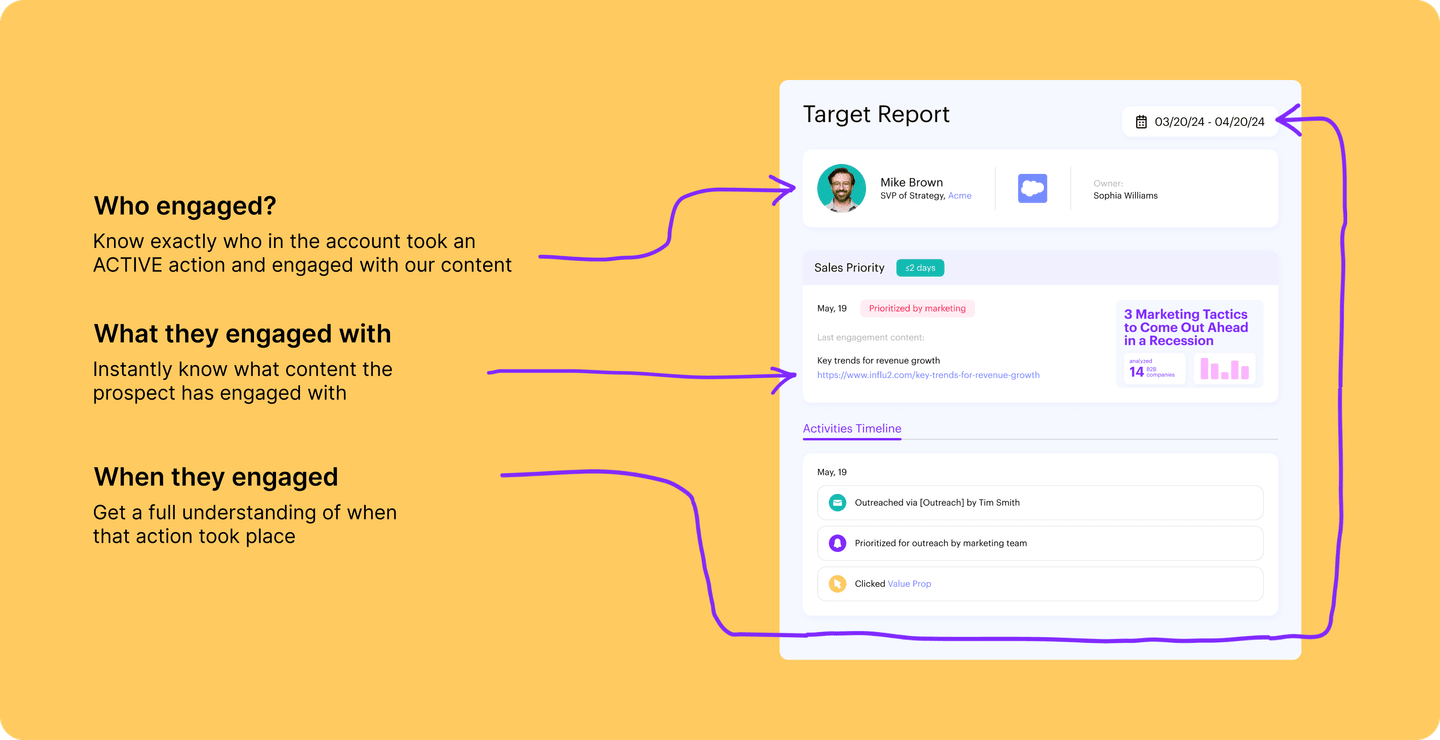
Account-level intent data gives you breadth, while contact-level intent data gives you depth.
Why ad engagement is a strong intent signal
Ad engagement (when tracked at the contact level) is specific, personal, and actionable.
Marketing can create first-party intent signals for the prospects that Sales is actively pursuing. When Sales has a new target prospect, Marketing can show them ads to generate buying intent signals.
So instead of waiting to receive account-level intent signals from a third-party supplier, you’re proactively creating and measuring buying intent at the contact level.
Let me illustrate.
You show multiple ads to a specific member of the buying group at a target account. Each ad has a different value proposition.
When that person clicks on a given ad, it's a sign that the message in that ad resonates with them.
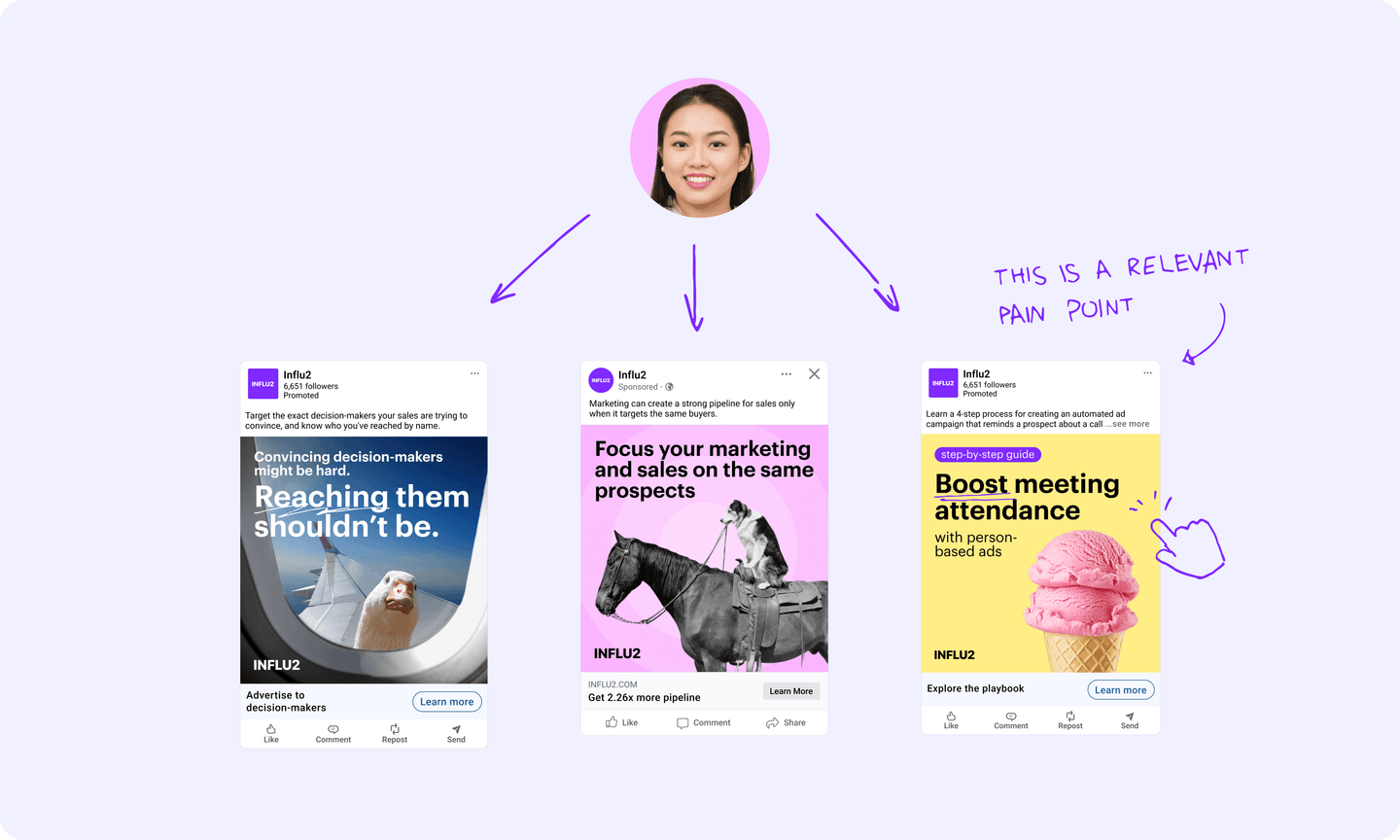
You’ve effectively created an intent signal that your salespeople can follow up on, and one that Marketing can use to show more relevant ads.
Knowing that a prospect clicked the “Boost meeting attendance” ad gives your sales rep a place to start the conversation with that person. Instead of leading with generic questions, they can focus their outreach on a known pain point for that specific prospect.
Similarly, it allows your marketing team to provide more relevant ads further down the funnel, such as promoting a case study that demonstrates how you’ve helped a previous customer improve their meeting attendance rate.
How to use contact-level intent signals to influence high-value deals
Engagement data from contact-level ads is a powerful indicator of buying interest. Here’s how to put it into practice to win enterprise deals.
Provide Sales with better context for outreach
Sales outreach that lacks context feels bland, generic, and impersonal.
Sales can use the intent signals marketing generates from contact-level ads to get the context they need for truly personalized outreach.
For instance, let’s say a social media management tool is targeting IKEA as a customer. The ABM team uses ads to target IKEA’s social media team, and their Social Media Director clicks on an ad highlighting their ability to prove the ROI of social.
A simple way for Sales to create an email that talks to that specific value proposition and draws a thread between the ad engagement and their outreach is to weave the ad messaging into the subject line and body of their email.

The email should focus on the value prop that drove that prospect to engage with your ad, not the ad engagement itself.
That is to say, “Hey, I saw you clicked our ad” isn’t the way to go. Most people would find that creepy, so it's not the most effective way to begin a conversation.
Prioritize the people showing the most intent
One of the biggest struggles we hear from salespeople using ABM software is the “engaged accounts” data they provide are incomplete.
Since they don’t know who from the account is actually engaged, salespeople have to spend hours doing additional research to try and find the person the signal came from. And even then, it’s a guessing game.
With contact-level intent data, you can see the exact person who’s engaged, not just the company name.
For example, say Zoho’s marketing team is targeting a 20-person buying group at Microsoft.
Which of those 20 people should Sales prioritize first?
Here’s how contact-level ad intent data can help you find the answer.
Marketing shows ads to all 20 people. Two of those people have clicked on at least one ad, but the other 18 haven’t engaged at all. They share this information with Sales automatically, via Influ2’s Sales Priorities dashboard.

Now Sales can reach out to the two people who have shown intent (with context), while Marketing keeps showing ads to the entire buying group.
It’s like allowing prospects to tell you what they’re interested in without having to fill out a form. Since you’re targeting specific people, Influ2 can match the ad click to your prospects, and that ad click is the intent signal.
Sales’ ability to act fast on buying intent signals is just as crucial.
When someone clicks your ad, your brand is top of mind. The recency effect—our tendency to be better at remembering the most recent information we receive—is at its peak.
The faster Sales contacts a recently engaged prospect, the more the recency effect is in play, and the more effectively they can open up a conversation.
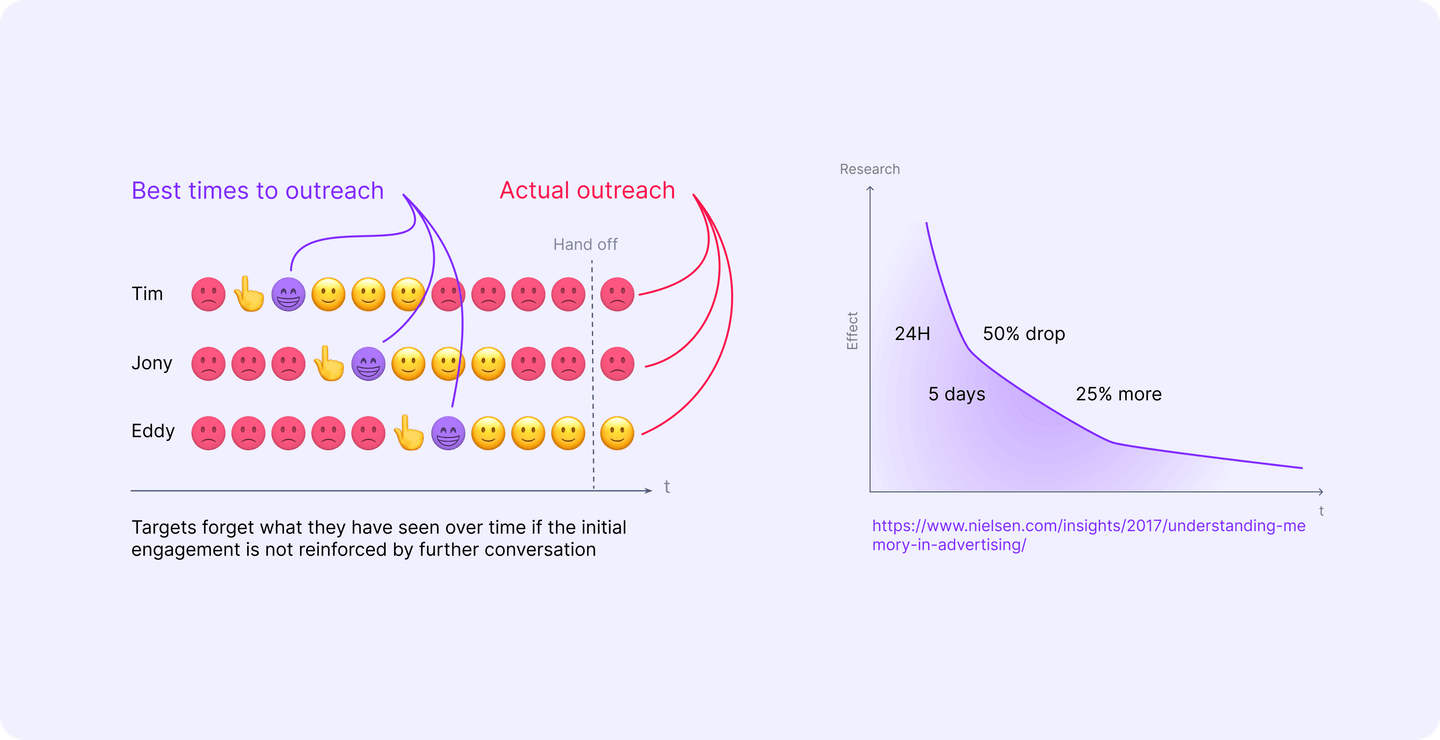
The best way to help Sales act quickly on intent signals is by using automation.
With Influ2, you can trigger notifications to Sales based on how prospects engage with your ads.
For example, if the VP of Marketing at Adobe clicks on a Zoho ad, the salesperson responsible for that account receives a notification containing:
- Who clicked the ad
- Which ad they clicked
- A link to the landing page they saw
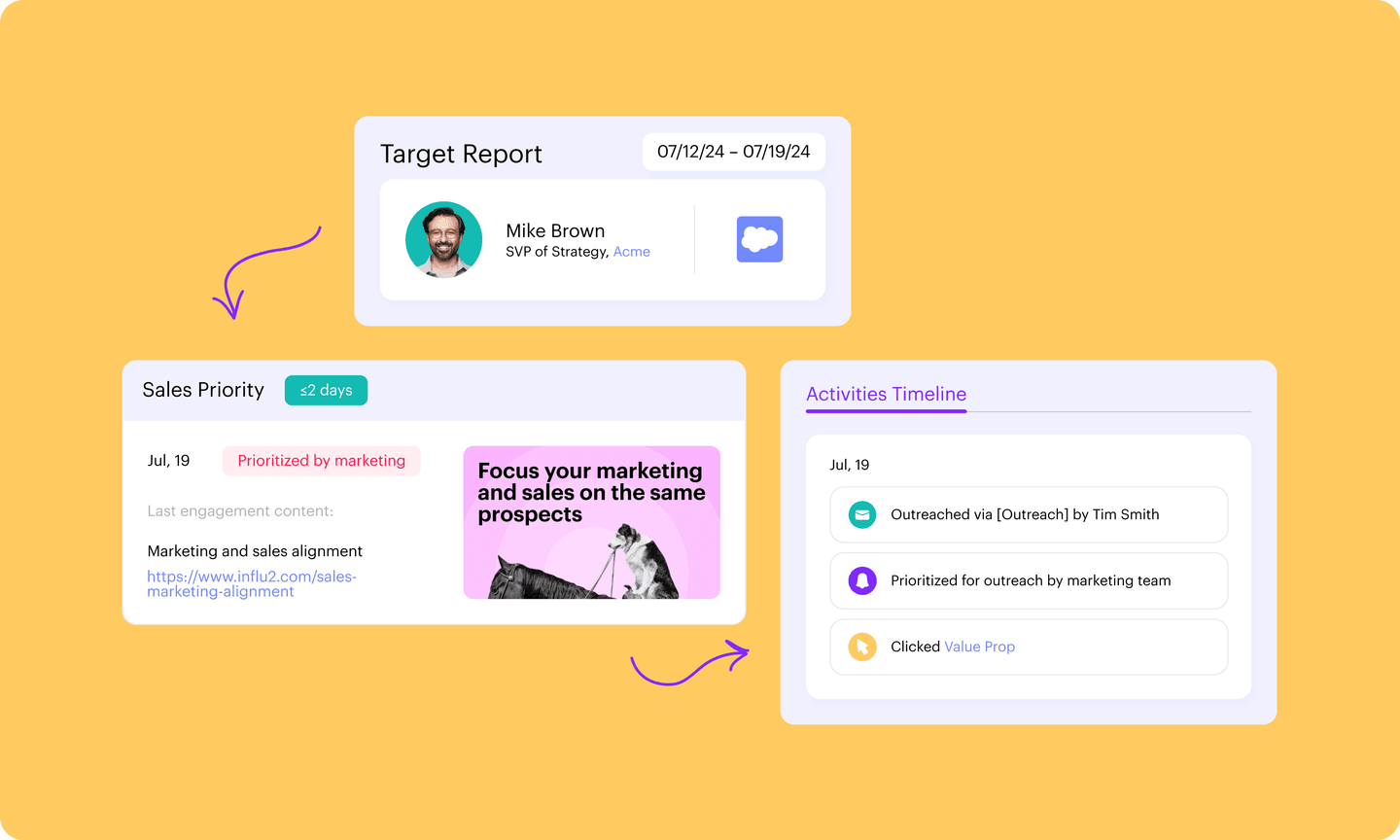
Help reduce churn
Every Revenue leader knows that growing the top line isn’t just about being good at acquisition; it also requires a strong customer retention program.
Intent signals can be an effective indicator of a customer that has a higher potential to churn, something that Customer Success will want to jump on ASAP.
Signals you can analyze here include:
- Product usage metrics (e.g., if sessions per week are dropping)
- Customer support tickets (e.g., if the client is logging more complaints)
- Billing and payments (e.g., if the customer is regularly late to pay)
- Online behavior (e.g., if the person is actively browsing competitor sites)
- Review sites (e.g., if someone at the account has posted a negative review about your company)
These signals should then be fed to the CSM on that account to provide contextual support and attempt to resolve any pressing issues.
Let’s say your revenue team notices a significant drop in usage from a specific account.
Your first-party historical data shows that once an account is inactive for, say, 30 days, they have a much higher likelihood of churning.
The third-party data you monitor also tells you that key stakeholders at the account have been browsing reviews of your competitors.
These are important churn signals for your team.
So, you put the account stakeholders into a retention journey that shows ads aimed at getting them back into the product.
You also have the CSM dig deeper to understand what’s causing the customer to look elsewhere, and then attempt an appropriate intervention (e.g. teaming up with a Sales Engineer to resolve some technical issues).
Identify opportunities to grow accounts
Intent signals aren’t just for winning new accounts, but also for growing existing ones.
Feature adoption, usage patterns, and content consumption habits are all powerful signals of intent you can use to identify upsell and cross-sell opportunities.
Imagine that CallRail has a customer on its “Call Tracking” plan, and is actively running an upsell campaign to boost expansion revenue for certain segments.

Marketing is feeding intent signals to the Success team, and they’ve uncovered that a key user at the account has:
- Clicked on an ad about Conversational Intelligence (first-party signal drawn from Influ2)
- Clicked three times on the Call Transcripts feature inside the platform (first-party signal drawn from product analytics)
- Searched for “CallRail Call Transcripts review” (third-party signal from browsing behavior)
All of these signals are fed into the CRM and demonstrate purchase intent, allowing the CSM to jump in and upsell them to CallRail’s “Call Tracking + Conversation Intelligence®” plan.
Track the downstream impact to refine your strategy
Attribution might be a contentious topic, but what’s clear is that marketers need a better way to measure the impact of their programs.
Contact-level intent signals can help here (if you’re using Influ2).
When a prospect at a target account clicks on your ad or has a certain number of ad impressions, we credit marketing with having influenced that deal. We can then tie that influence directly to pipeline and revenue.
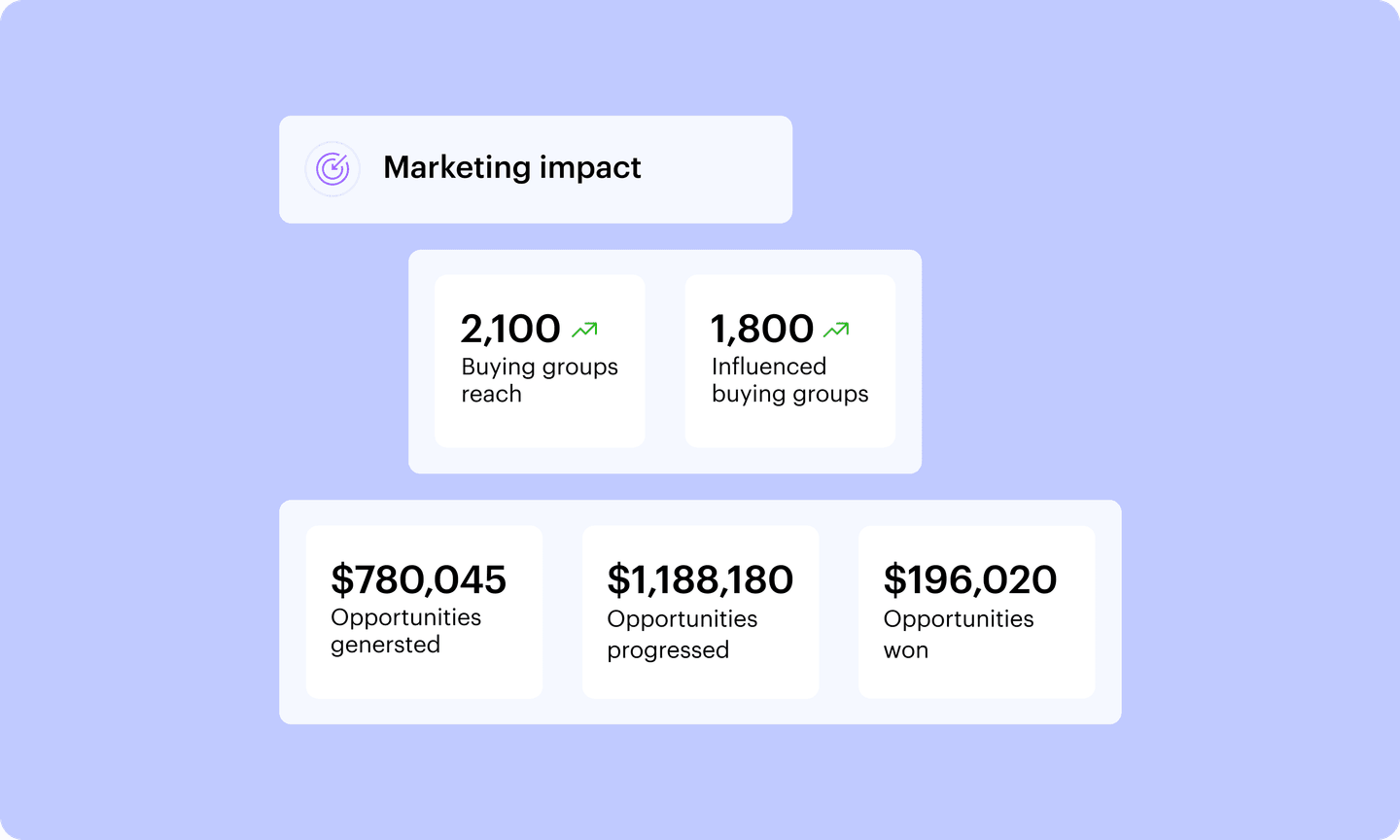
Check out this guide for more information on how we connect intent signals to revenue—How Marketing-Influenced Revenue Clarifies What Attribution Misses.
Final thoughts
Intent signals drive more focused, effective B2B outreach by highlighting where buyer interest actually lies.
Utilizing first, second, and third-party data in unison offers a richer, more accurate view of potential customers, especially if you’re able to access contact-level intent data.
Influ2 is the only contact-level ABM that offers that level of depth. It you're interested in learning how it works, let’s talk!



